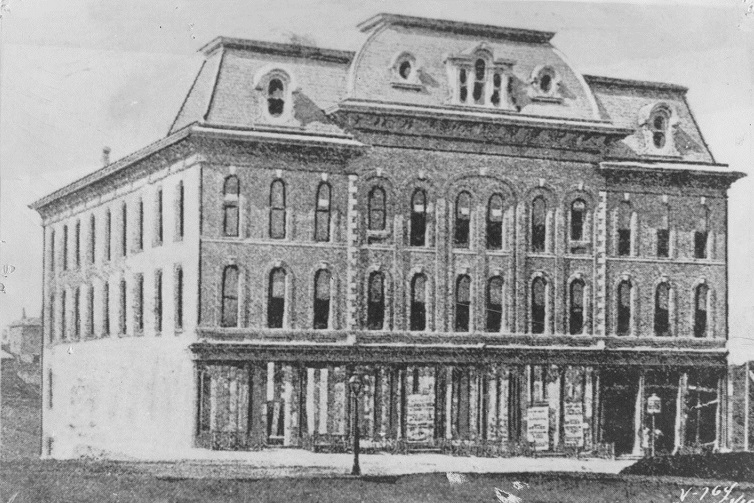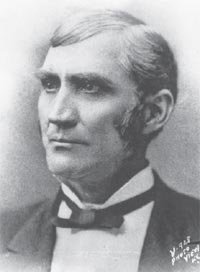On January 31, 1901, the Coates Opera House, which was Kansas City’s original first-class theater, met a fate common among nineteenth-century theaters when it burned to the ground. Boiler rooms for heating, hot gas or electric stage lights, and large crowds of people crammed into small spaces made theatergoing a distinct fire hazard.
The 31-year-old building burned to the ground shortly following the performance of Heart and Sword, starring Walker Whiteside and Leilia Wolstan. Had the two actors performed the longer Hamlet, as originally scheduled, hundreds of occupants would have been in danger. Fortunately, no one was harmed in the disaster as the actors who remained in the building broke through windows to escape.
There were no fatalities, but other losses were heavy. Whiteside’s touring company lost thousands of dollars worth of props and costumes. More devastating to Kansas City was the loss of the opera house that served as the symbolic center of culture in "Cow Town" for three decades.
Kersey and Sarah Coates left Pennsylvania in 1856 to settle in Kansas City. Despite their sheltered Quaker upbringing, they sought out the rough, but promising town then called the City of Kansas. Kersey Coates gained social standing from his informal support of the Union Army, for which the Missouri Militia awarded him the official rank of Colonel. Likewise, Sarah Coates gained attention for nursing both Union and Confederate soldiers at a crude hospital set up in Lockridge Hall, a public assembly hall standing at the intersection of 5th and Main streets. Following the war, Kersey Coates opened a bank, invested in real estate, built the Coates House Hotel at present-day 10th Street and Broadway, and was one of the most important local leaders who helped attract railroad lines to Kansas City.
For the quickly growing city to become truly exceptional, Coates believed it needed an opera house that could bring first-class entertainment to Kansas City. He paid for the $105,000 opera house himself and positioned it across the street from the Coates House Hotel at 10th and Broadway and near his residence at 10th and Pennsylvania on what would later develop into Quality Hill. At the time, Quality Hill rested outside the city limits, so theatergoers in 1870 had to ride carriages or walk on muddy, unpaved roads through pastures to reach the spectacular Coates Opera House. Protecting their finest suits and dresses during the journey was the greatest challenge.
Despite the remote location at the present-day northwest corner of 10th and Broadway, the Coates Opera House proved to be very popular. To Coates' disdain, the theater had to supplement elite theatrical opera performances with lower-class theater productions which could draw larger crowds on a frequent basis, but the building became a cultural gathering place with balls, concerts, opera productions, lectures, and minstrel shows. Kersey Coates also proved to be something of a visionary when the city expanded to the southwest to surround the Coates Opera House on Quality Hill and develop in the West Bottoms during the 1870s and 1880s. The Coates Opera House was not in a remote location for long.
In hopes that the Coates family or the city would rebuild the theater, no one touched the rubble for 10 years after the building burned to the ground. It would never be rebuilt, however, because by 1901 several other opera houses stood in Kansas City, and the Coates Opera House was less central to the civic welfare of the city. Finally, in 1910 the Rothenburg and Schloss tobacco firm cleared the rubble and built a warehouse where the Coates Opera House had been.
Read biographical sketches of Kersey and Sarah Coates, prepared by the Missouri Valley Special Collections, The Kansas City Public Library.
- Biography of Kersey Coates (1923-1887), Civic Leader, by Barbara Magerl, 2003
- Biography of Sarah Chandler Coates (1923-1897), Community Leader, by Barbara Magerl, 1999
View images of the Coates Opera House, hotel, and residence that are a part of the Missouri Valley Special Collections.
- Kersey Coates Homestead, about 1860
- Broadway Boulevard with Opera House in background, 1870
- Coates Opera House, front view, 1871
- Coates Opera House, 1886
- Coates Opera House, with some remodeling work completed, 1900
- Coates House Hotel and Opera House, 1871
- Coates House Hotel, 1950
- Coates House Hotel today as apartments
Check out the following books about the Coates Opera House.
- The Enchanted Years of the Stage: Kansas City at the Crossroads of American Theater, 1870-1930, by Felicia Hardison Londré; includes a chapter dedicated to the Coates Opera House, pp. 32-62
- Kansas City Style: A Social and Cultural History of Kansas City as Seen through its Lost Architecture, by Dory DeAngelo and Jane Fifield Flynn; contains a short synopsis and photographs of the Coates Opera House, pp. 52-53
- The Development of Kansas City Theatre from 1856 to 1871, by Suzanne E. Kaslaitis-Townley
Continue researching the Coates Opera House using archival material from the Missouri Valley Special Collections.
References:
DeAngelo, Dory. What About Kansas City!: A Historical Handbook. Kansas City, MO: Two Lane Press, 1995.
Londré, Felicia Hardison. The Enchanted Years of the Stage: Kansas City at the Crossroads of American Theater, 1870-1930. Columbia: University of Missouri Press, 2007.
Magerl, Barbara. Biography of Kersey Coates (1923-1887), Civic Leader. Missouri Valley Special Collections, 2003.
Magerl, Barbara. Biography of Sarah Chandler Coates (1923-1897), Community Leader. Missouri Valley Special Collections, 1999.
Montgomery, Rick and Shirl Kasper. Kansas City: An American Story. Kansas City, MO: Kansas City Star Books, 1999.



